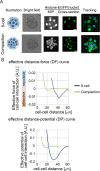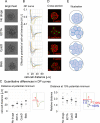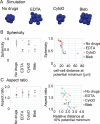Effective mechanical potential of cell-cell interaction explains three-dimensional morphologies during early embryogenesis
- PMID: 37549166
- PMCID: PMC10434874
- DOI: 10.1371/journal.pcbi.1011306
Effective mechanical potential of cell-cell interaction explains three-dimensional morphologies during early embryogenesis
Abstract
Mechanical forces are critical for the emergence of diverse three-dimensional morphologies of multicellular systems. However, it remains unclear what kind of mechanical parameters at cellular level substantially contribute to tissue morphologies. This is largely due to technical limitations of live measurements of cellular forces. Here we developed a framework for inferring and modeling mechanical forces of cell-cell interactions. First, by analogy to coarse-grained models in molecular and colloidal sciences, we approximated cells as particles, where mean forces (i.e. effective forces) of pairwise cell-cell interactions are considered. Then, the forces were statistically inferred by fitting the mathematical model to cell tracking data. This method was validated by using synthetic cell tracking data resembling various in vivo situations. Application of our method to the cells in the early embryos of mice and the nematode Caenorhabditis elegans revealed that cell-cell interaction forces can be written as a pairwise potential energy in a manner dependent on cell-cell distances. Importantly, the profiles of the pairwise potentials were quantitatively different among species and embryonic stages, and the quantitative differences correctly described the differences of their morphological features such as spherical vs. distorted cell aggregates, and tightly vs. non-tightly assembled aggregates. We conclude that the effective pairwise potential of cell-cell interactions is a live measurable parameter whose quantitative differences can be a parameter describing three-dimensional tissue morphologies.
Copyright: © 2023 Koyama et al. This is an open access article distributed under the terms of the Creative Commons Attribution License, which permits unrestricted use, distribution, and reproduction in any medium, provided the original author and source are credited.
Conflict of interest statement
The authors have declared that no competing interests exist.
Figures








Similar articles
-
Effective mechanical potential of cell-cell interaction in tissues harboring cavity and in cell sheet toward morphogenesis.Front Cell Dev Biol. 2024 Jul 22;12:1414601. doi: 10.3389/fcell.2024.1414601. eCollection 2024. Front Cell Dev Biol. 2024. PMID: 39105171 Free PMC article.
-
Cell position-based evaluation of mechanical features of cells in multicellular systems.J Theor Biol. 2025 May 7;604:112070. doi: 10.1016/j.jtbi.2025.112070. Epub 2025 Feb 18. J Theor Biol. 2025. PMID: 39978539
-
Cell tracking in live Caenorhabditis elegans embryos via third harmonic generation imaging microscopy measurements.J Biomed Opt. 2011 Apr;16(4):046019. doi: 10.1117/1.3569615. J Biomed Opt. 2011. PMID: 21529088
-
Autophagy and apoptosis are redundantly required for C. elegans embryogenesis.Autophagy. 2011 May;7(5):557-9. doi: 10.4161/auto.7.5.14685. Epub 2011 May 1. Autophagy. 2011. PMID: 21285529 Review.
-
C. elegans Embryonic Morphogenesis.Curr Top Dev Biol. 2016;116:597-616. doi: 10.1016/bs.ctdb.2015.11.012. Epub 2016 Feb 1. Curr Top Dev Biol. 2016. PMID: 26970644 Review.
Cited by
-
The maximum size of cell-aggregates is determined by the competition between the strain energy and the binding energy of cells.Heliyon. 2024 Nov 20;10(23):e40560. doi: 10.1016/j.heliyon.2024.e40560. eCollection 2024 Dec 15. Heliyon. 2024. PMID: 39654728 Free PMC article.
-
A new paradigm considering multicellular adhesion, repulsion and attraction represent diverse cellular tile patterns.PLoS Comput Biol. 2025 Apr 21;21(4):e1011909. doi: 10.1371/journal.pcbi.1011909. eCollection 2025 Apr. PLoS Comput Biol. 2025. PMID: 40258228 Free PMC article.
-
Emergence of multiple collective motility modes in a physical model of cell chains.NPJ Syst Biol Appl. 2025 May 22;11(1):52. doi: 10.1038/s41540-025-00529-7. NPJ Syst Biol Appl. 2025. PMID: 40404682 Free PMC article.
-
Effective mechanical potential of cell-cell interaction in tissues harboring cavity and in cell sheet toward morphogenesis.Front Cell Dev Biol. 2024 Jul 22;12:1414601. doi: 10.3389/fcell.2024.1414601. eCollection 2024. Front Cell Dev Biol. 2024. PMID: 39105171 Free PMC article.
-
An ImageJ-based tool for three-dimensional registration between different types of microscopic images.Dev Growth Differ. 2023 Jan;65(1):65-74. doi: 10.1111/dgd.12835. Epub 2023 Jan 14. Dev Growth Differ. 2023. PMID: 36576380 Free PMC article.
References
Publication types
MeSH terms
LinkOut - more resources
Full Text Sources

